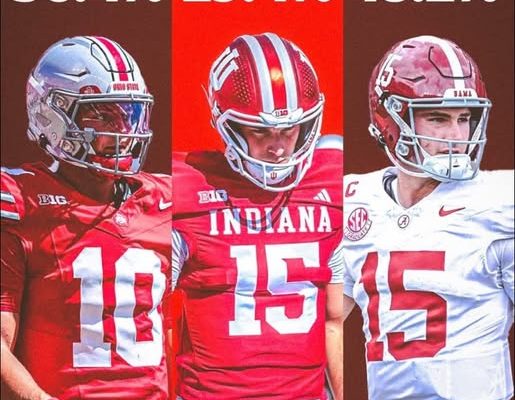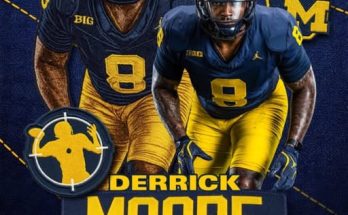The 2025 college football season has provided fans with thrilling storylines, standout performances, and unexpected twists, but perhaps none has captured the imagination quite like the emerging three-way race for the Heisman Trophy. At the center of this battle are three electrifying quarterbacks: Julian Sayin, Fernando Mendoza, and Ty Simpson. Each of these young talents has carved out a season filled with highlight-reel plays, statistical dominance, and leadership moments that have not only elevated their respective programs but also ignited intense national debate over who deserves college football’s most prestigious individual honor.
Julian Sayin has been nothing short of sensational. The California native and star quarterback has displayed a level of poise and precision that many analysts would expect from a seasoned professional rather than a collegiate athlete still in the early stages of his career. Sayin’s arm talent is undeniable. Week after week, he has demonstrated the ability to dissect defenses, threading passes into tight windows and consistently delivering the football with velocity and accuracy. But what sets Sayin apart from other quarterbacks is not just his arm strength or mechanics; it is his cerebral approach to the game. He reads coverages with an almost instinctual understanding, anticipates pressure before it arrives, and adjusts on the fly in ways that elevate his entire offense.
Statistically, Sayin has posted numbers that are not only impressive but historic for his program. He has consistently ranked among the national leaders in passing yards, touchdowns, and completion percentage, all while maintaining an exceptionally low interception rate. More than raw numbers, though, his performances in critical moments have defined his season. Against top-tier opponents, Sayin has orchestrated comeback drives, made clutch throws in high-pressure situations, and displayed leadership that galvanizes his teammates. The intangible qualities—the ability to stay calm under duress, to command the huddle, and to make those around him better—have drawn comparisons to previous Heisman-winning quarterbacks who combined statistical dominance with transformative leadership.
On the other side of the country, Fernando Mendoza has emerged as a force of nature. Mendoza, known for his dual-threat capabilities, has brought a dynamic style of play that is difficult for any defense to contain. While Sayin thrives in a traditional pocket-passing system, Mendoza’s game thrives on unpredictability. He can extend plays with his legs, scramble into open space, and create opportunities where none seem to exist. His rushing statistics alone make him a constant threat; defenders must account for every movement, which opens up passing lanes that Mendoza exploits with uncanny timing and accuracy. This versatility has allowed Mendoza to lead his team to victories in games where a more one-dimensional quarterback might have faltered.
Mendoza’s season has been highlighted by explosive plays that frequently make highlight reels, whether it’s a 60-yard touchdown run where he evades multiple tacklers or a perfectly placed deep ball to a receiver streaking down the sideline. He combines athleticism with a high football IQ, and it is this combination that has made him a nightmare for defensive coordinators. Furthermore, Mendoza’s leadership is visible in his sideline demeanor. His teammates often mirror his energy and intensity, a testament to his ability to inspire and rally those around him. While some critics have questioned whether his style of play might leave him vulnerable to injuries, Mendoza has shown remarkable durability and consistency, further strengthening his case for the Heisman.
Then there is Ty Simpson, the third pillar in this emerging Heisman narrative. Simpson has carved out a distinct identity as a quarterback who blends size, arm strength, and mobility in a manner that challenges defenses in every aspect of the game. What sets Simpson apart is his ability to elevate his team’s play in high-stakes situations. Throughout the season, he has consistently delivered in crunch time, whether it is engineering game-winning drives, escaping collapsing pockets, or throwing pinpoint passes on critical downs. Simpson’s statistical output rivals that of both Sayin and Mendoza, with impressive yardage totals, a high touchdown-to-interception ratio, and efficiency metrics that place him among the nation’s elite quarterbacks.
Simpson’s style is often described as methodical yet explosive. He demonstrates a clear understanding of situational football and makes intelligent decisions while still possessing the physical tools to turn a broken play into a scoring opportunity. His coaches frequently praise his work ethic, and it shows in his preparation and on-field execution. Unlike Mendoza, whose brilliance often shines in improvisation, or Sayin, whose precision defines his play, Simpson combines both traits, making him perhaps the most balanced quarterback among the three. His ability to mix the run and the pass seamlessly, along with his calm and confident leadership, has turned his program into one of the most formidable in the country this season.
The narrative surrounding this three-way Heisman race has been fueled not only by individual statistics but also by the broader context of team success and media coverage. Sayin, Mendoza, and Simpson each represent programs that have captured national attention. The wins, the marquee matchups, and the dramatic finishes have kept each player in the spotlight and created a constant buzz in college football circles. Fans debate endlessly about the merits of each candidate. Sayin’s precision versus Mendoza’s dual-threat explosiveness versus Simpson’s balanced dominance—these are the talking points that fill social media feeds, television broadcasts, and sports radio shows daily. Analysts pour over every statistic, every game film, and every highlight, attempting to parse which qualities should weigh most heavily in the voting process.
Another layer to the discussion is the intangible factor that has historically influenced Heisman Trophy outcomes: narrative. Sayin’s story as a highly touted recruit who has fulfilled expectations with poise and consistency resonates with traditionalists. Mendoza’s exciting, dynamic style of play appeals to fans who appreciate the game’s unpredictability and flair. Simpson’s combination of resilience, leadership, and balanced production creates a compelling case for voters seeking both statistical excellence and on-field impact. Each narrative is distinct yet equally persuasive, creating a rare and captivating three-way race that is unlikely to be decided until the final weeks of the season.
Moreover, the level of competition each quarterback has faced adds another dimension to the debate. Sayin has navigated a gauntlet of strong defenses with precision, Mendoza has shredded defensive schemes with versatility and creativity, and Simpson has demonstrated clutch performance in tight, high-pressure contests. When evaluating Heisman candidates, context matters. A quarterback who can elevate his team against top-tier opponents and perform under pressure has traditionally had an edge, and in this regard, all three candidates boast credentials that merit serious consideration.
Voters also weigh leadership and intangibles alongside statistics. Sayin’s calm, cerebral approach, Mendoza’s infectious energy and resilience, and Simpson’s balance of skill and intelligence all showcase leadership in different ways. Each quarterback has demonstrated the ability to rally teammates, maintain composure under pressure, and inspire confidence across the roster. These qualities, while difficult to quantify, often tip the scales in close Heisman races. It is this combination of measurable performance and intangible impact that has made this three-way battle one of the most intriguing in recent memory.
Beyond individual accomplishments, the Heisman race often reflects broader trends in college football. The emergence of these three quarterbacks illustrates the evolution of the position, blending traditional pocket-passing skills with athleticism, decision-making, and versatility. Sayin represents the archetype of a technically sound, precise quarterback; Mendoza embodies the modern dual-threat quarterback who can change games with legs and arm alike; and Simpson offers a hybrid model that showcases both mobility and pure passing ability. Together, they demonstrate the multifaceted nature of quarterback play in the 2025 season, offering a glimpse into how the position continues to develop and influence the landscape of the sport.
The debate surrounding this Heisman race will likely continue to intensify as the season progresses. Every game becomes a referendum on their candidacies. Strong performances will bolster their standing, while missteps could shift the narrative in unexpected ways. For fans, analysts, and casual observers alike, the excitement lies in the unpredictability of the outcome. Each quarterback brings a distinct style, a compelling story, and a body of work that merits serious consideration. The decision will ultimately rest with voters who must weigh statistics, team success, individual brilliance, and the elusive quality of leadership.
As the season approaches its climax, the anticipation surrounding the Heisman Trophy has never been higher. Sayin, Mendoza, and Simpson have transcended the role of mere candidates; they have become symbols of excellence, determination, and the thrill of college football at its highest level. Their performances have captivated audiences, energized fan bases, and provided a week-to-week spectacle that reinforces why the Heisman Trophy remains the pinnacle of individual achievement in the sport.
While it is impossible to predict with certainty who will ultimately claim the award, what is clear is that this three-way battle has already left a lasting mark on the 2025 season. Each quarterback has showcased extraordinary talent, resilience, and leadership, reminding fans and analysts alike why college football continues to inspire passion and debate. The season will continue to unfold, and with it, the story of the Heisman Trophy race will reach its dramatic conclusion. Whether it is Sayin’s pinpoint passing, Mendoza’s electrifying dual-threat play, or Simpson’s balanced dominance that ultimately prevails, one thing is certain: the 2025 Heisman race will be remembered as one of the most thrilling, closely contested, and exhilarating competitions in recent memory.
As fans eagerly track every snap, every touchdown, and every clutch performance, the narratives of Julian Sayin, Fernando Mendoza, and Ty Simpson will continue to intertwine, driving conversation and speculation to fever pitch. Their journeys exemplify the heart of college football: talent, determination, and the pursuit of greatness. In the end, the winner of the Heisman Trophy will not only have proven himself on the field but will have also cemented his place in the annals of the sport, joining an elite pantheon of players whose performances define seasons and captivate generations. Until that moment arrives, the eyes of the football world remain firmly fixed on this extraordinary three-way battle, where every game, every play, and every decision carries the weight of Heisman destiny.



